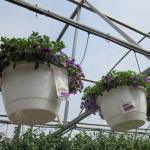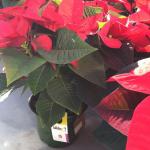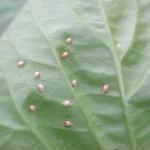Beneficial Insects and Mites from Greenhouses to You
Many greenhouses that grow flowering plants for sale in Massachusetts are using beneficial insects and mites to manage pests. Beneficial insects and mites are good bugs that feed on plant pests in the greenhouse. There are three types of beneficials used in greenhouse production, predators, parasitoids and pathogens.
Predators are insects and mites that feed on pests but do not reproduce in them. They eat more than one pest as they develop throughout their life cycle to adults. Predators are less picky than parasitoids about the pests they eat. Predators often deposit their eggs near pests so when the eggs hatch, there is a food source nearby to provide nourishment. Minute pirate bugs, aphid predatory midge, predatory mites, rove beetles and lady beetles are predators used in greenhouses.
Examples of predators that you would find outdoors in your own gardens are lady beetles, ground beetles, lacewings, Minute pirate bug, Hover fly, Aphid predatory midge, Tachinid fly, many spiders (crab spider, jumping spider, wolf spider).
Parasitoids are insects that deposit eggs in or directly on a pest. The parasitoid develops inside the pest and kills it. The adult parasitoid emerges from the pest and the cycle continues. Parasitoids are very host-specific and eat only a single pest as they develop. Parasitoids are commonly used in greenhouses to kill whitefly and aphid pests. Female wasps have an ovipositor that allows them to deposit eggs on or in the pest’s body. They also have a narrow “waist” which allows their abdomens to be highly flexible. While the size of parasitoids is quite variable, the ones used for greenhouse pests are very, small.
Examples of parasitoids found outdoors in your garden are braconid wasp that kills aphids and caterpillars and Ichneumonids that feed on armyworms and European corn borer. Next time you see aphids on a plant, look carefully. You are likely to see tan, puffy aphid bodies that have had the insides eaten by a braconid wasp. One adult wasp emerges from each of the parasitized aphids, leaving an exit hole and an empty body. The puffy bodies look like a popcorn kernel.
Growers of greenhouse crops also use pathogens that are organisms that cause a fatal disease in pests. Beneficial pathogens include fungi, bacteria and viruses which do not harm plants. Pathogens are mixed with water and sprayed on the insects pests on the plants and the insects eventually die.
Beneficial insects and mites are packaged in plastic bottles, cardboard tubes or in little sachets the size of tea bags and shipped overnight by commercial companies. The growers release them into the greenhouse as soon as they arrive. Some types of beneficials are distributed throughout the greenhouse by sprinkling them around by hand. In very large greenhouse ranges, beneficials may be distributed using a blower. Sachets that contain predatory mites are often used in hanging baskets or in individual pots. Beneficial nematodes are mixed with water and watered into the soil where the nematodes can infect the immature stage of fungus gnats. Some types of beneficial insects used in greenhouses already live here in Massachusetts, while others do not and will die over the winter.
Beneficial insects used in greenhouses will not bite or sting humans and most are so small, that an untrained eye would not know they were there.
In addition to beneficial insects and mites, yellow sticky cards are used to monitor pest activity in greenhouses. Yellow is attractive to adult flying insects in greenhouses which are caught onto the sticky substance on the card. The grower can then count adult flying insects such as fungus gnats, shore flies, whiteflies and thrips that they find on the sticky cards each week to keep track of populations of pests.
So, if you purchased a plant that has a little tea bag packet in it (they are not placed in every plant), or see puffy tan aphids, it is because the grower you purchased the plants from is using beneficial insects and mites to manage pests in their greenhouse and in your garden and reducing the amount of pesticides used!
Resource to identify beneficials in your own garden: Biocontrol (Michigan State University)



